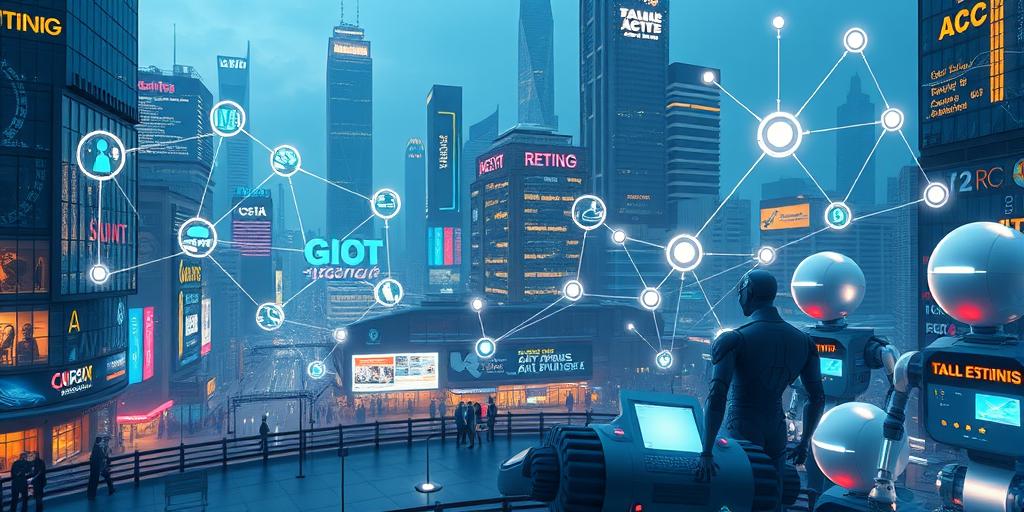It seems like everywhere you look, there’s something new powered by AI in technology. From the way we search the internet to the healthcare advancements we’re witnessing, AI is rapidly transforming our world. But why this sudden explosion of AI in Technology? Let’s dive into the factors driving this technological revolution.
1. The Rise of AI: A Technological Revolution
1. From Science Fiction to Reality
For decades, AI remained largely confined to the realm of science fiction. Think robots, sentient computers, and futuristic scenarios depicted in movies and books. However, recent breakthroughs have propelled AI from theoretical concept to tangible reality. The development of powerful algorithms, coupled with exponential increases in computing power, has finally enabled us to build and deploy AI systems capable of performing complex tasks previously considered the exclusive domain of humans. We’re no longer talking about theoretical possibilities; we’re witnessing real-world applications of AI impacting every aspect of our lives.
2. The Power of Data and Computing
The sheer volume of data generated daily fuels the AI revolution. This data, ranging from social media interactions to scientific research, provides the raw material for training sophisticated AI models. Simultaneously, advancements in computing power, particularly the rise of cloud computing and specialized AI hardware like GPUs, have made it feasible to process and analyze this immense data deluge. This synergy between vast data sets and powerful computational resources is the engine driving the current AI boom, enabling the development of increasingly complex and capable AI systems. This creates a powerful feedback loop; more data leads to better models, which in turn lead to even more data collection and analysis.
2. Key Drivers of AI Adoption
1. Advancements in Machine Learning
Machine learning (ML), a subset of AI, has seen remarkable progress in recent years. Deep learning, a type of ML using artificial neural networks, has achieved breakthroughs in image recognition, natural language processing, and other fields. These advancements have made it possible to build AI systems that can learn from data without explicit programming, leading to more accurate and efficient solutions. The development of new algorithms and techniques continues to push the boundaries of what’s possible with AI in technology.
2. Increased Data Availability
The digital age has resulted in an unprecedented explosion of data. This massive amount of information, generated by various sources, provides the fuel for training increasingly sophisticated AI models. From social media interactions and online transactions to sensor data from IoT devices, the availability of data is a crucial factor driving the proliferation of AI in technology. The ability to access and analyze this data is key to unlocking the full potential of AI.
3. Cloud Computing and Scalability
Cloud computing has played a pivotal role in making AI accessible to a wider range of businesses and researchers. The scalability and cost-effectiveness of cloud platforms allow developers to train and deploy AI models without needing substantial upfront investment in infrastructure. This democratization of AI is a significant contributor to its widespread adoption, allowing even smaller companies to leverage the power of AI in their operations. Cloud services also provide readily accessible tools and APIs for integrating AI into existing systems.
4. Growing Business Demand
Businesses across various sectors recognize the transformative potential of AI. The ability to automate tasks, improve efficiency, and gain insights from data is driving strong demand for AI solutions. Companies are investing heavily in AI to gain a competitive edge, leading to increased innovation and development in the field. From streamlining operations to enhancing customer experiences, AI is becoming an indispensable tool for businesses seeking growth and success. This increased business demand further fuels investment and innovation in the field.
3. AI Applications Across Industries
1. Healthcare: Diagnosis, Treatment, and Drug Discovery
AI is revolutionizing healthcare through improved diagnostics, personalized treatment plans, and accelerated drug discovery. AI algorithms can analyze medical images with remarkable accuracy, assisting doctors in detecting diseases like cancer at earlier stages. AI-powered tools also personalize treatment plans based on individual patient data, improving outcomes and reducing side effects. The application of AI in drug discovery accelerates the process of identifying potential drug candidates, significantly reducing research and development time. This is leading to advancements that are transforming patient care and improving overall health outcomes. Examples include AI-powered diagnostic tools and robotic surgery systems.
2. Finance: Fraud Detection, Risk Assessment, and Personalized Investing
The finance industry utilizes AI for fraud detection, risk assessment, and personalized investing. AI algorithms can identify suspicious transactions in real-time, preventing fraud and protecting financial institutions. AI-powered risk assessment tools provide more accurate and efficient credit scoring and loan approvals. Personalized investment strategies, tailored to individual investor profiles, are made possible by AI algorithms that analyze market trends and individual risk tolerances. The use of AI in finance is continuously evolving, leading to more secure and efficient financial systems.
3. Retail: Personalized Recommendations and Customer Service
AI is transforming the retail landscape by providing personalized recommendations and enhancing customer service. E-commerce platforms utilize AI algorithms to suggest products based on individual customer preferences and purchase history. AI-powered chatbots provide instant customer support, answering questions and resolving issues efficiently. Personalized marketing campaigns, targeted to specific customer segments, improve conversion rates and increase sales. This results in a more engaging and efficient shopping experience for consumers.
4. Manufacturing: Automation, Predictive Maintenance, and Supply Chain Optimization
In manufacturing, AI is driving automation, predictive maintenance, and supply chain optimization. AI-powered robots perform repetitive tasks with high precision and efficiency, increasing productivity and reducing costs. Predictive maintenance algorithms analyze sensor data from machinery to predict potential failures, preventing costly downtime. AI optimizes supply chains by improving inventory management, forecasting demand, and streamlining logistics. This increases efficiency and reduces waste throughout the manufacturing process.
5. Transportation: Autonomous Vehicles and Traffic Management
The transportation industry is being reshaped by AI-powered autonomous vehicles and intelligent traffic management systems. Self-driving cars utilize AI algorithms to navigate roads, avoiding obstacles and ensuring passenger safety. Intelligent traffic management systems optimize traffic flow, reducing congestion and improving travel times. These advancements promise to revolutionize transportation, making it safer, more efficient, and more sustainable. This technology is still developing, but the potential impact is immense.
4. The Future of AI: Opportunities and Challenges
1. Ethical Considerations and Bias
As AI becomes increasingly prevalent, ethical considerations and the potential for bias become paramount. AI systems are trained on data, and if that data reflects existing societal biases, the AI system will likely perpetuate and even amplify those biases. Addressing these ethical concerns requires careful consideration of data selection, algorithm design, and ongoing monitoring of AI systems for fairness and accountability. Transparency and explainability are also crucial aspects of responsible AI development.
2. Job Displacement and Workforce Transformation
The automation potential of AI raises concerns about job displacement. Certain jobs may become obsolete as AI-powered systems take over routine tasks. However, AI is also creating new job opportunities in areas such as AI development, data science, and AI ethics. A proactive approach to workforce transformation is crucial, focusing on reskilling and upskilling initiatives to prepare the workforce for the changing job market. Adapting to the changing landscape is key to navigating this challenge successfully.
3. The Importance of Responsible AI Development
Responsible AI development is crucial to ensuring that AI benefits humanity. This includes developing AI systems that are ethical, unbiased, and transparent. Collaboration between researchers, policymakers, and industry leaders is essential to establishing guidelines and standards for responsible AI development. International cooperation is also necessary to address global challenges related to AI governance and deployment. The development of responsible AI is not merely a technical challenge; it’s a societal imperative.
5. Embracing the AI Revolution
AI is rapidly transforming our world, presenting both incredible opportunities and significant challenges. The key to successfully navigating this transformation lies in embracing responsible innovation, fostering collaboration, and addressing ethical concerns proactively. By working together, we can harness the transformative power of AI to create a more equitable, sustainable, and prosperous future. The future of AI in Technology is bright, but it requires careful consideration and a commitment to responsible development. The ongoing advancements and applications of AI will continue to reshape our world in ways we’re only beginning to understand.




